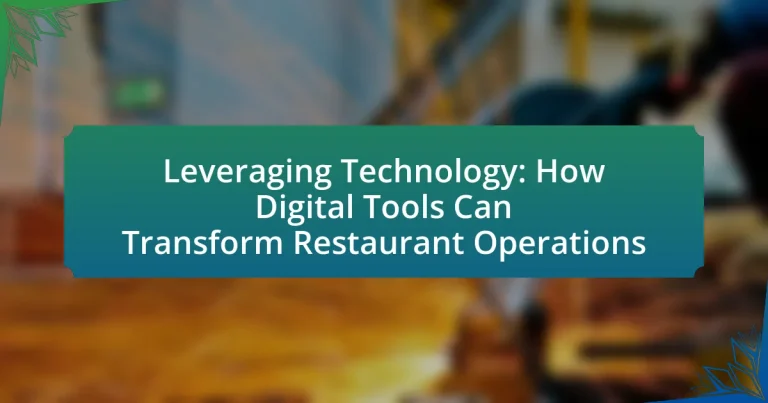Leveraging technology in restaurant operations involves the strategic implementation of digital tools to enhance efficiency, improve customer experience, and streamline processes. Key technologies include point-of-sale systems, online ordering platforms, inventory management software, and customer relationship management tools, which collectively optimize workflows and reduce costs. The article explores how these technologies transform various operational areas, such as order management, inventory control, and staff scheduling, while also addressing the challenges restaurants face without technology. Additionally, it highlights the importance of adopting digital tools for better customer engagement, operational transparency, and long-term financial benefits, along with best practices for successful technology integration and staff training.

What is Leveraging Technology in Restaurant Operations?
Leveraging technology in restaurant operations refers to the strategic use of digital tools and systems to enhance efficiency, improve customer experience, and streamline processes. This includes implementing point-of-sale systems, online ordering platforms, inventory management software, and customer relationship management tools. For instance, a study by the National Restaurant Association found that 70% of restaurant operators believe technology improves their operations, leading to increased sales and customer satisfaction. By integrating these technologies, restaurants can optimize workflows, reduce labor costs, and provide personalized services, ultimately driving profitability and growth.
How can digital tools enhance restaurant efficiency?
Digital tools enhance restaurant efficiency by streamlining operations, improving communication, and optimizing resource management. For instance, point-of-sale systems automate order processing, reducing wait times and minimizing errors, which can lead to a 20% increase in table turnover rates. Additionally, inventory management software helps track stock levels in real-time, preventing overstocking or shortages, thus saving costs and reducing waste. Furthermore, online reservation systems improve customer flow and enhance the dining experience, contributing to higher customer satisfaction and repeat business. These tools collectively enable restaurants to operate more smoothly and profitably.
What specific technologies are commonly used in restaurants?
Common technologies used in restaurants include point-of-sale (POS) systems, kitchen display systems (KDS), online ordering platforms, and inventory management software. POS systems streamline transactions and track sales data, while KDS enhances communication between front-of-house and kitchen staff by displaying orders digitally. Online ordering platforms facilitate customer orders through websites or apps, and inventory management software helps track stock levels and reduce waste. These technologies collectively improve operational efficiency, enhance customer experience, and support data-driven decision-making in the restaurant industry.
How do these technologies streamline daily operations?
Technologies streamline daily operations by automating routine tasks, enhancing communication, and improving data management. Automation reduces manual labor, allowing staff to focus on customer service and food preparation, which increases efficiency. For example, point-of-sale systems can quickly process transactions and manage inventory in real-time, reducing errors and saving time. Enhanced communication tools, such as messaging apps and scheduling software, facilitate better coordination among staff, leading to smoother service and quicker response times. Additionally, data management technologies enable restaurants to analyze sales trends and customer preferences, allowing for informed decision-making that optimizes operations and boosts profitability.
Why is it important for restaurants to adopt digital tools?
It is important for restaurants to adopt digital tools because these technologies enhance operational efficiency and improve customer experience. Digital tools streamline processes such as online ordering, reservations, and payment systems, which can lead to increased sales and reduced wait times. For instance, a study by Toast found that 70% of customers prefer to order online, indicating that digital ordering systems can significantly boost a restaurant’s revenue. Additionally, digital tools enable better inventory management and data analytics, allowing restaurants to make informed decisions based on customer preferences and sales trends. This integration of technology not only meets customer expectations but also positions restaurants competitively in a rapidly evolving market.
What challenges do restaurants face without technology?
Restaurants face significant challenges without technology, including inefficiencies in operations, difficulty in managing inventory, and limited customer engagement. Without technology, restaurants struggle to streamline processes such as order taking and payment processing, leading to longer wait times and decreased customer satisfaction. Additionally, manual inventory management can result in overstocking or stockouts, negatively impacting profitability. Furthermore, the absence of digital marketing tools limits a restaurant’s ability to reach potential customers and engage with existing ones, which is crucial in a competitive market. These challenges highlight the critical role technology plays in enhancing operational efficiency and customer experience in the restaurant industry.
How does technology improve customer experience in restaurants?
Technology improves customer experience in restaurants by streamlining operations and enhancing service delivery. For instance, digital ordering systems allow customers to place orders quickly and accurately, reducing wait times and minimizing errors. According to a study by Toast, 70% of diners prefer to order through a digital platform, indicating that technology meets customer preferences. Additionally, customer relationship management (CRM) systems enable restaurants to personalize marketing efforts and improve customer engagement, leading to increased satisfaction and loyalty. These advancements demonstrate that technology not only enhances efficiency but also aligns with customer expectations, ultimately improving their overall dining experience.

What are the key areas of restaurant operations transformed by technology?
The key areas of restaurant operations transformed by technology include order management, inventory control, customer engagement, and staff scheduling. Order management systems streamline the ordering process, reducing errors and improving efficiency. Inventory control technologies, such as automated tracking systems, help restaurants manage stock levels and reduce waste, leading to cost savings. Customer engagement tools, including mobile apps and loyalty programs, enhance the dining experience and foster customer loyalty. Additionally, staff scheduling software optimizes labor management, ensuring that restaurants are adequately staffed during peak times while minimizing labor costs. These transformations are supported by data showing that restaurants utilizing technology can increase operational efficiency by up to 30%.
How does technology impact inventory management?
Technology significantly enhances inventory management by automating processes, improving accuracy, and providing real-time data insights. Automation reduces human error and streamlines tasks such as stock tracking and order processing, which can lead to a 20-30% reduction in inventory costs, as reported by the National Restaurant Association. Real-time data analytics allows businesses to monitor inventory levels, forecast demand, and make informed purchasing decisions, ultimately increasing efficiency and reducing waste. Furthermore, technologies like RFID and barcode scanning facilitate quicker stocktaking and inventory audits, ensuring that businesses maintain optimal stock levels and minimize losses.
What tools are available for effective inventory tracking?
Effective inventory tracking tools include inventory management software, barcode scanning systems, and RFID technology. Inventory management software, such as Square for Restaurants and MarketMan, allows restaurants to monitor stock levels, track orders, and manage suppliers in real-time. Barcode scanning systems streamline the inventory process by enabling quick data entry and reducing human error, while RFID technology provides automated tracking of inventory items, enhancing accuracy and efficiency. According to a study by the National Restaurant Association, implementing these technologies can lead to a 20% reduction in food waste and improved operational efficiency.
How can technology reduce food waste in restaurants?
Technology can reduce food waste in restaurants by implementing inventory management systems that track stock levels and expiration dates. These systems enable restaurants to optimize their purchasing and usage, minimizing overstocking and spoilage. For instance, a study by the Food Waste Reduction Alliance found that restaurants using such technology can reduce food waste by up to 30%. Additionally, data analytics can help identify patterns in food consumption, allowing restaurants to adjust their menus and portion sizes accordingly, further decreasing waste.
In what ways does technology enhance staff management?
Technology enhances staff management by streamlining communication, automating scheduling, and improving performance tracking. Digital tools such as instant messaging platforms facilitate real-time communication among team members, reducing misunderstandings and increasing collaboration. Automated scheduling software allows managers to efficiently allocate shifts based on employee availability and workload, minimizing scheduling conflicts and optimizing labor costs. Additionally, performance management systems provide data-driven insights into employee productivity and engagement, enabling targeted training and development initiatives. According to a study by the Society for Human Resource Management, organizations that utilize technology for staff management report a 20% increase in employee satisfaction and a 15% improvement in retention rates.
What software solutions assist in scheduling and payroll?
Software solutions that assist in scheduling and payroll include platforms like Deputy, When I Work, and Gusto. Deputy offers features for employee scheduling, time tracking, and payroll management, streamlining operations for businesses. When I Work focuses on employee scheduling and communication, allowing managers to create schedules and track hours efficiently. Gusto provides payroll processing, benefits management, and compliance tools, making it easier for businesses to manage employee compensation and related tasks. These solutions enhance operational efficiency and accuracy in payroll and scheduling processes.
How can digital tools improve staff training and development?
Digital tools can improve staff training and development by providing interactive and personalized learning experiences. These tools, such as e-learning platforms and mobile applications, enable employees to access training materials anytime and anywhere, facilitating flexible learning that accommodates different schedules and learning paces. For instance, a study by the Brandon Hall Group found that organizations using digital learning tools experience a 42% increase in employee engagement and retention of information compared to traditional training methods. Additionally, digital tools often include analytics features that allow managers to track progress and identify areas for improvement, ensuring that training is effective and tailored to individual needs.

What are the benefits of leveraging technology in restaurant operations?
Leveraging technology in restaurant operations enhances efficiency, improves customer experience, and increases profitability. For instance, point-of-sale systems streamline order processing, reducing wait times and minimizing errors. According to a study by the National Restaurant Association, 70% of operators reported that technology improved their overall efficiency. Additionally, online reservation systems and mobile ordering apps cater to customer preferences, leading to higher satisfaction rates. Data analytics tools enable restaurants to optimize inventory management, reducing food waste and lowering costs, which can increase profit margins by up to 10%.
How does technology contribute to cost savings?
Technology contributes to cost savings by streamlining operations, reducing labor costs, and minimizing waste. For instance, digital tools such as point-of-sale systems and inventory management software automate order processing and inventory tracking, which decreases the time staff spend on these tasks. According to a study by the National Restaurant Association, restaurants that implement technology solutions can reduce labor costs by up to 20%. Additionally, technology enables better forecasting and inventory control, leading to a reduction in food waste, which can account for as much as 10% of a restaurant’s operating costs. Thus, the integration of technology directly correlates with significant cost reductions in restaurant operations.
What are the long-term financial benefits of adopting digital tools?
The long-term financial benefits of adopting digital tools include increased operational efficiency, reduced labor costs, and enhanced customer engagement. Digital tools streamline processes such as inventory management and order processing, leading to significant time savings and lower operational costs. For instance, a study by the National Restaurant Association found that restaurants implementing digital ordering systems saw a 20% increase in order accuracy, which directly correlates to higher customer satisfaction and repeat business. Additionally, digital tools enable better data analytics, allowing restaurants to make informed decisions that optimize pricing and menu offerings, ultimately driving revenue growth.
How can technology improve operational transparency?
Technology can improve operational transparency by enabling real-time data sharing and communication across all levels of an organization. For instance, cloud-based management systems allow restaurant operators to access and share information about inventory, sales, and employee performance instantly, fostering accountability and informed decision-making. According to a study by the National Restaurant Association, 70% of restaurant operators reported that technology has enhanced their ability to monitor operations and improve service delivery, demonstrating the effectiveness of digital tools in promoting transparency.
What role does technology play in marketing and customer engagement?
Technology plays a crucial role in marketing and customer engagement by enabling personalized communication and enhancing customer experiences. Digital tools such as social media platforms, email marketing, and customer relationship management (CRM) systems allow businesses to target specific audiences with tailored messages, increasing the effectiveness of marketing campaigns. For instance, a study by McKinsey & Company found that companies using advanced analytics in their marketing strategies can achieve a 15-20% increase in sales. Additionally, technology facilitates real-time feedback through online reviews and social media interactions, allowing businesses to adapt their strategies quickly to meet customer needs. This dynamic interaction fosters stronger relationships between brands and consumers, ultimately driving customer loyalty and retention.
How can restaurants utilize social media and online platforms effectively?
Restaurants can utilize social media and online platforms effectively by engaging with customers through targeted content, promotions, and community interaction. By creating visually appealing posts showcasing menu items, restaurants can attract attention; for instance, studies show that posts with images receive 94% more engagement than text-only posts. Additionally, leveraging platforms like Instagram and Facebook for promotions, such as limited-time offers or events, can drive traffic and increase sales. Engaging with customers through comments and messages fosters loyalty, as 70% of consumers feel more connected to brands that respond to their inquiries. Utilizing analytics tools available on these platforms allows restaurants to track engagement and adjust strategies based on customer preferences, ensuring that their online presence aligns with their target audience’s interests.
What are the best practices for using customer data to enhance service?
The best practices for using customer data to enhance service include collecting data ethically, analyzing customer preferences, personalizing interactions, and continuously updating data strategies. Collecting data ethically ensures compliance with regulations like GDPR, which protects customer privacy and builds trust. Analyzing customer preferences allows restaurants to tailor menus and promotions, leading to increased customer satisfaction; for instance, a study by McKinsey found that personalized experiences can increase customer loyalty by up to 20%. Personalizing interactions, such as addressing customers by name and recommending dishes based on past orders, enhances the dining experience and fosters customer relationships. Continuously updating data strategies ensures that restaurants adapt to changing customer behaviors and preferences, which is crucial in a dynamic market.
What are the potential challenges of implementing technology in restaurants?
The potential challenges of implementing technology in restaurants include high initial costs, staff resistance to change, and the need for ongoing maintenance and updates. High initial costs can deter restaurants from adopting new technologies, as investments in hardware, software, and training can be substantial. Staff resistance often arises due to fear of job displacement or discomfort with new systems, which can hinder effective implementation. Additionally, ongoing maintenance and updates are necessary to ensure technology remains functional and secure, requiring dedicated resources and expertise. According to a survey by the National Restaurant Association, 70% of restaurant operators reported that technology implementation was challenging due to these factors, highlighting the significance of addressing these issues for successful integration.
How can restaurants overcome resistance to change among staff?
Restaurants can overcome resistance to change among staff by implementing effective communication strategies and involving employees in the change process. Engaging staff through open discussions about the benefits of new technologies fosters a sense of ownership and reduces anxiety. Research indicates that organizations that involve employees in decision-making processes experience a 30% increase in acceptance of change initiatives. Additionally, providing training and support helps staff feel more confident in adapting to new tools, which can lead to a smoother transition and improved operational efficiency.
What are the common pitfalls to avoid during technology integration?
Common pitfalls to avoid during technology integration include inadequate planning, lack of employee training, and failure to assess compatibility with existing systems. Inadequate planning can lead to misalignment between technology capabilities and business needs, resulting in wasted resources. Lack of employee training often results in underutilization of new tools, as staff may not fully understand how to leverage the technology effectively. Additionally, failing to assess compatibility with existing systems can cause disruptions in operations, as new technologies may not integrate smoothly with legacy systems. These pitfalls can hinder the successful implementation of digital tools in restaurant operations, ultimately affecting efficiency and customer satisfaction.
What practical steps can restaurants take to successfully leverage technology?
Restaurants can successfully leverage technology by implementing online ordering systems, utilizing point-of-sale (POS) systems, and adopting customer relationship management (CRM) software. Online ordering systems streamline the ordering process, allowing customers to place orders directly from their devices, which can increase sales; for instance, a study by Toast found that restaurants offering online ordering saw a 30% increase in revenue. POS systems enhance operational efficiency by automating transactions and inventory management, reducing human error and improving service speed. Additionally, CRM software helps restaurants analyze customer data to tailor marketing efforts and improve customer engagement, leading to higher retention rates. By integrating these technologies, restaurants can enhance customer experience, optimize operations, and drive profitability.
How should restaurants assess their technology needs?
Restaurants should assess their technology needs by conducting a comprehensive evaluation of their operational processes, customer interactions, and specific pain points. This assessment involves identifying areas where technology can enhance efficiency, improve customer experience, and streamline operations. For instance, restaurants can analyze their order management systems, inventory control, and customer relationship management to determine which technologies can optimize these functions. According to a report by the National Restaurant Association, 70% of restaurant operators believe that technology can improve their business operations, highlighting the importance of aligning technology investments with operational goals.
What are the best practices for training staff on new digital tools?
The best practices for training staff on new digital tools include providing hands-on training, utilizing a phased approach, and ensuring ongoing support. Hands-on training allows staff to engage directly with the tools, which enhances retention and understanding. A phased approach, where training is broken down into manageable segments, helps prevent overwhelm and allows staff to build confidence gradually. Ongoing support, such as access to resources and a help desk, ensures that staff can troubleshoot issues as they arise, leading to higher adoption rates. Research indicates that organizations that implement structured training programs see a 30% increase in employee productivity and satisfaction, demonstrating the effectiveness of these practices.




